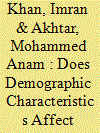| Srl | Item |
| 1 |
ID:
181309


|
|
|
|
|
| Summary/Abstract |
The United Arab Emirates (UAE) is a popular destination for migrant workers worldwide, not just from Asia. Along with expanding the UAE’s economic activities, the amount of remittance outflows has increased dramatically, making it the second-largest remitting country, just behind the United States. This study looks into the important demographic factors that influence migrant remittance behavior in the Emirates. The examinations revealed that age, race, marital status, and a number of dependents are the most important factors influencing remittance behavior, while gender is found to be insignificant, proving the popular premise of female altruism to be incorrect. The findings are expected to assist policymakers in the government in devising ways and means to reduce remittance outflows as they have vital implications for some key macro-economic variables such as inflation and exchange rate as well as financial service providers in the UAE, in orchestrating a suitable promotional strategy to target suitable cohorts.
|
|
|
|
|
|
|
|
|
|
|
|
|
|
|
|
| 2 |
ID:
085380


|
|
|
|
|
| Publication |
2009.
|
| Summary/Abstract |
A cohort perspective contrasting four historical generations of American men reveals sharp differences in the extent to which each generation served on active military duty, in the share of that service that occurred during wartime and in the battlefield ages from seventeen to twenty-four, in the resulting rates of combat-related deaths, and in certain features of selectivity with respect to military service-chiefly education. Service data from Defense Department sources combined with population data from computerized census files produce these military profiles of the Hard Timers, Good Warriors, Lucky Few, and Baby Boomers.
|
|
|
|
|
|
|
|
|
|
|
|
|
|
|
|